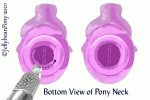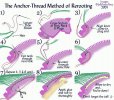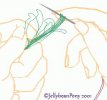:: opens mouth, flood of instruction comes out ::
The basic method is always the same on a pony with the chain-stitched loop braid inside: find the end that the stitch completed on (on G1 ponies this is always the bottom of the neck) and begin yanking whole, single plugs in succession from that end. Each stitched plug of hair looped through the next, so if the last one is pulled, each adjacent plug can be pulled one at a time to free up the one that was stitched just before. You'll often see a G1 pony where the last plug or two is short or already missing because of the way this stitch can be pulled out (it usually indicates a mane that is going to come out more easily). Often there will be a glued wad of hair at the end, which was the only way the makers had to finish and secure the stitching.
I use a sturdy needle to part the hair plugs and separate them from each other. Sometimes they're distinct and this is easy, other times two or even 3 plugs seem to be mashed together as one, which is harder to interpret. The holes in the vinyl can be your guide. It will always be the hairs closest to the end that will be "unlocked," and a plug is always happiest to come out all at once. Wrap it several times around a finger or a smooth object like a sharpie pen and give a firm pull, holding all the fibers as one. When you've pulled out one clean bundled loop, it's a win!
Pull too few fibers and you get a snarl of loops out (with patience, you can still sort this snarl out). Too many and it won't go, because some of those fibers are actually the next plug over and still secured by the one you're working on. When having trouble, pull too few and either patiently sort these back onto a needle (see illustration from previous post) or discard them. Just remember if you're transferring a mane directly or removing it for deep cleaning the roots, you'll need to keep all you can, unless you have more fiber you can supplement with.
Then there is the issue of the glue itself. Some ponies got very little glue and plugs come out cleanly. Some were just crusted with glue and you have to use scissors and/or pliers to remove the blob of end-hair before plugs will start coming out. Most often on G1s, the glue has become brittle with age, and will break down into granules (so work over a surface you can clean). Sometimes you can encourage the glue to break down further by squishing the interior braid with a blunt hard object. This can break some fibers, though.
If glue granules are stuck to your loops, feed all the fibers of a loop onto a needle, hold the free ends taut, and scratch the snugly wrapped loops with a fingernail to get the debris off. This is also the way to clean mildew residue from the roots of a grody pony that you really want to restore.
If loops are coming out broken, keep going to see if this stops higher up the mane and gives you any you can salvage.
If you're tugging and tugging and a loop just won't come out, it may be partially locked into the parallel braid, which means the other row was stitched last and should be pulled first. Try working on that row and see if it helps. You can alternate rows if that cooperates better.
Many of you will read this and go "NO THANKS" and return to scissoring off manes for total replacement, LOL. You do you!! I'm fortunate enough to have time to do this kind of detail work and I really like reusing things that are still good. And it's just neat to know it can be done, if you want to! I like how familiar it's made me with the various levels of ease or difficulty the stitchers had with installing these manes. Some are clean and beautiful, some are bushy and glued to heck.
Give it a try, see what you get. If you just can't deal with reusing the hair, your pony will still be bald and ready for whatever method of rehair you like.





